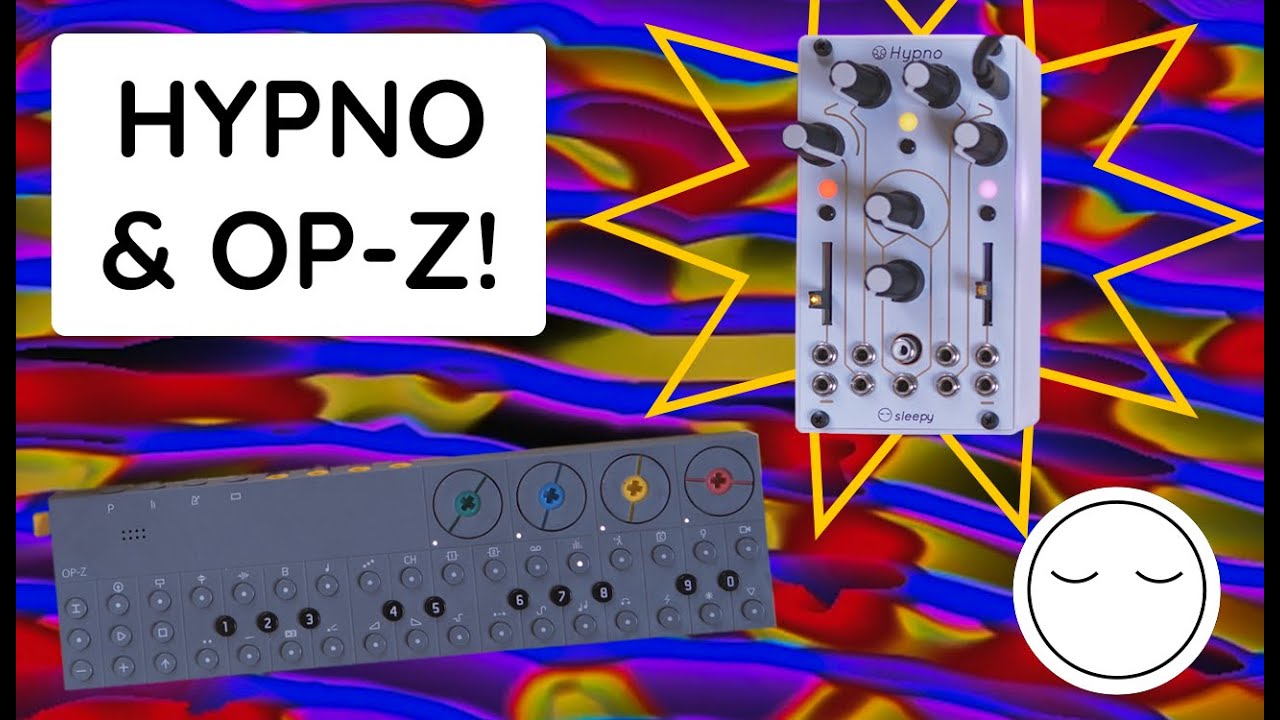By far the most common question we receive about Hypno is “Can I make Hypno react to music?” and fortunately the short answer is yes! Thanks to Hypno’s CV inputs and MIDI implementation, you can put together visual patches that react to audio or are synchronized with your music hardware. We’ve compiled this post to go over all the best techniques and tips!
Table of Contents:
- The Case for Asynchronous Visuals and Music
- Tutorial Videos
- Understanding Voltage and Modular Synthesizers
- Using Your Modular Synth to Animate Hypno
- Generating Control Voltages from Music
- Understanding Hypno’s MIDI implementation
- Synchronized MIDI Sequencing and Modulation
The Case for Asynchronous Visuals and Music
Hypno has a multitude of built in modulations to animate its parameters. These alone will add a great deal of motion to your patch. Despite the lack of external synchronization, you can still make outstanding visuals for music using asynchronous modulations. Certainly, the effect of visuals pumping and swaying along to a beat can be entrancing, but take time to explore the internal modulations and dial in the timing by hand. When cycling elements in music and video are slightly out of sync, the resulting phase effects can really be quite appealing. Sometimes the best audio-visual experiences are the ones you didn’t entirely expect to create.
Tutorial Videos
Our video tutorial with the Moog Mother-32 goes over the basics of controlling Hypno with eurorack format synthesizers.
Learn how to control and sequence Hypno’s visuals using MIDI on the Teenage Engineering OP-Z.
Understanding Voltage and Modular Synthesizers
At the heart of all analog synthesizers are continuous electrical signals, which are measured in volts, and the speed at which voltage changes is called frequency (or Hertz/Hz). At high enough frequencies, voltage ultimately controls the movement in the cones of your speakers or the electron guns of your CRT television, allowing us to generate audio and video. Audio typically occupies a range of 20Hz-20,000Hz, whereas analog video is up into the MHz (millions of Hertz). If you’re curious to learn more about how voltages and modular synths work, there are countless YouTube videos on the topic!
In the sub-audio range (<20Hz), we can’t hear these voltage fluctuations anymore, however we can employ them to hear or see changes over time from your synthesizer. When these “slow” currents are used to modulate another value, we refer to them as control voltages or CV. CV comes in many forms, but in general you can expect modular synthesizers to work within a range of +5V to -5V, which is also what Hypno expects through its CV inputs.
For the sake of simplicity, we can categorize CV sources into four main categories: LFOs, envelopes, random, and sequencers.
- LFOs, or Low Frequency Oscillators, produce cycling voltages in waveforms like triangle, sine, saw and square. Use these to modulate Hypno with automatically repeating motion that is synced or unsynced to your music.
- Envelope generators, in contrast to LFOs, produce “one shot” voltage changes, typically consisting of two or more stages, like an attack (rising) and decay (falling) stage. Unlike LFOs, envelopes need to be triggered externally (though some envelopes can be looped), so in a visual context they are good for creating single events of animation, such as when a new note is played.
- Sequencers are capable of playing back a number of voltage values in a predetermined or novel order, clocked or triggered by your system. This would allow you to create repeating sequences of values, much like sequencing pitch.
- Random modules produce continuous, non-repeating voltages, derived in various ways such as sampling noise. Despite the irregular nature of random voltage, they are dependent on clock or trigger signals, which could be synced to your audio patch, or linked with musical events.
There are many, many other functions you can use in modularland, but these basic four types should get you started. Check out ModularGrid to start exploring the vast number of modules that exist!
Using Your Modular Synth to Animate Hypno
Most if not all modular and semi-modular synthesizers are capable of generating CV for external patching, allowing your musical control signals to animate your Hypno patches perfectly in step with your music! It is as easy as patching an LFO or envelope from your synth to one of Hypno’s seven CV inputs. Voila! You can have Shape A frequency follow along to your filter cutoff, or fade the master gain in and out with the same signals controlling your VCA.
The possibilities are quite endless with just a few simple functions at your disposal, and there are a thousand more options when you begin exploring Eurorack modules. If you need a few suggestions, we have a running list of Our Favorite Eurorack Modulators for Hypno.
Taking advantage of CV modulation doesn’t come without its complications, however, as different makers and modules will output different ranges of voltage. For instance, it is not uncommon for LFOs to output a bipolar voltage from -5V to +5V, while envelope generators typically output unipolar 0-5V signals. To help you navigate some of these complexities, here are a handful of tips, with some helpful terms bolded if you want to do more independent research!
- Hypno’s CV inputs accept a range of +5V to -5V; a +5V signal would be the equivalent of turning the knob or slider to its maximum position/value, and a -5V signal would be the minimum position/value.
- Voltages above or below +/-5V range will be clipped, i.e. the parameter has gone as high or as low as possible and the CV has hit a “wall” for applying further change. Note: a little extra voltage won’t hurt Hypno, but definitely avoid patching signals above +/-12V as this could damage your module.
- Incoming CV is summed with the parameter’s knob position, which allows you to offset the modulation by a specific amount.
- In many cases, you will want to scale or attenuate your CV, depending on how much modulation you actually want applied. You don’t always want your modulation to go from 0-100!
- Some CV signals may also require amplification, especially if you’re coming from the LZX ecosystem, which uses a 0-1V standard.
- Use multiples or stackcables to split CV sources out to Hypno, effecting parallel changes in your music and visuals.
- To create more complex CV, use mixers and VCAs to combine LFOs and envelopes in creative ways
Now that’s you’ve mastered the basics of modulating Hypno with CV, you can apply that knowledge to making Hypno dance along with your modular music compositions! Make sure to show us your favorite audiovisual patches in the Sharing category, and divulge your secret techniques in the replies below!
Generating Control Voltages from Music
All of the above is probably great if you’re a modular musician, but sometimes we just want to use audio from someone else’s live performance or music recording and make our visuals dance! Fortunately, there are several simple solutions to this, albeit with a little additional hardware required.
- Just patch the music in! Providing you can bring the music into the module, you can patch this directly into one of Hypno’s CV inputs. The provides a usable audioreactive effect, but fast or busy music will likely translate into jittery motions as Hypno’s CV inputs are reading every minuscule peak in the audio. Note: standard line level audio may need amplification to Eurorack levels. Read this article by Perfect Circuit for a detailed explanation of live level vs. Eurorack level.
- If “beat reactive” visuals are what you’re after, then an envelope follower is what you want. This type of module/function creates rising and falling voltages based on the volume peaks of audio. Our friends at Noise Engineering put out a great article about these modules!
- Alternatively, you can use a low-pass filter to “smooth out” the busy peaks of music. This isn’t quite as effective as an envelope follower, but it works.
- An EQ can let you carve out a slice of the audio spectrum, which is great if you want to isolate the kick drum or hihats and use them individually to effect your visual modulation.
- Get the click track! Nothing will get you in time with the band like getting the click track. Use this to synchronize or trigger events in your system and Hypnotize crowds.
There are definitely more great techniques for making Hypno react to live audio, post your favorite methods in the replies below!
Understanding Hypno’s MIDI implementation
Hypno is equipped with USB-MIDI Host capability, meaning it can accept incoming MIDI CC (continuous controller) and note messages from USB-MIDI client devices, such as MIDI keyboards and controllers, as well as grooveboxes and synthesizers. If you’re not up to speed with how MIDI works, this video is a great primer. Note that host to host MIDI connections, such as between Hypno and a computer, are not currently supported.
Every parameter in Hypno is mapped to a corresponding CC#, which has a range of 0-127 (128 step resolution). When Hypno receives a CC message from your controller, the module translates that message into parameter value changes, thus an external knob, slider, or button can edit or manipulate Hypno’s engine. This can be very handy given that Hypno has more editable parameters than hardware knobs, so a controller can bring you hands on access to those features. Furthermore, presets for Hypno can be recalled using a MIDI keyboard.
A map of the module’s CC assignments is always available on the Hypno Manual page, and you’ll find some video quick guides on using MIDI control too. We also keep a running list of USB accessories that are known to work with Hypno. Just so you know, any incoming MIDI messages will override the front panel knob positions and the CV inputs
Synchronized MIDI Sequencing and Modulation
Additional hands on control is great, but better than that, however, is using a MIDI sequencer to create audiovisual compositions with Hypno! Many grooveboxes, arrangers, and drum machines are equipped with additional MIDI tracks for controlling external gear.
If you’ve sequenced other synths with your MIDI devices, then using it with Hypno should be a breeze. In either case, here are some tips and tricks!
- Sequence CC values in patterns to change Hypno’s parameters in perfect time with your music
- Change presets in time with the music by writing MIDI note sequences
- Use MIDI LFOs and other automations to create tempo-synced animations
- Polymetric MIDI sequences can create modulation patterns that are less repetitive
- Features like probability and random are always helpful for adding a little unpredictability to your modulations
As you can tell, Hypno has amazing potential for being used in audiovisual performances and compositions. Please share your favorite devices, modules, techniques and methods for creating audiovisual patches with Hypno!

